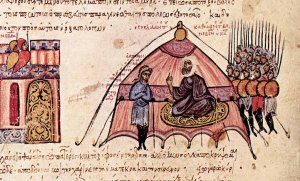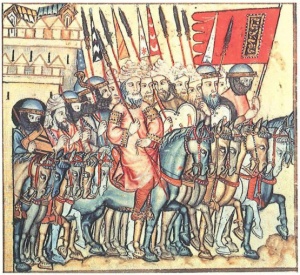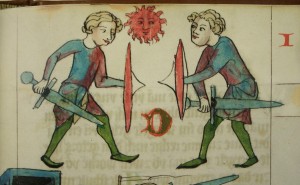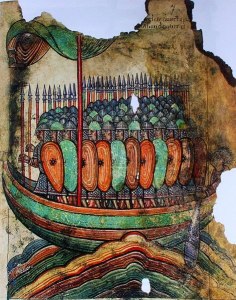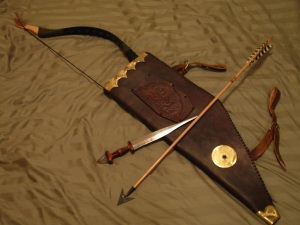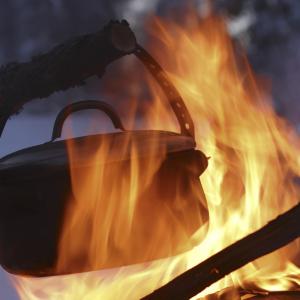Latest Event Updates
An Exchange of Culture, Sponsored by Halvgrimr Riddari
Saturday evening (during the post revel) there will be a short meeting of the envoys from both the Viking and Andalusian armies.
After the original defeat at Seville, the Arab diplomat Al-Ghazal (“the gazelle”) was dispatched to the court of the Danish King Harek at Hleiðra (as recounted in Ibn-Dihya) to make peace with the Danes followed their defeat.
We intend to recreate this event so that folks might experience the sort of peaceful cultural exchange that might have taken place at that time.
Hope to see you all there!
Equestrian Activities at the Siege of Seville
Youth Combat at the Siege of Seville!!!
Youth Marshall: Duke Dongal Eriksson
Youth Combat:
Starts at 1pm
There will be training, singles and melees.
Including a boat scenario!
Rattan Schedule for the Siege of Seville
Rattan Marshall in charge, Duke Dongal Eriksson
Inspections/Authorizations: 9-10 am
10am Fighting scenarios start
Skirmish Resurrection battle
Longship Battle
Bridge Battle
Field battle
Retreat battle
2pm – “Melee God” Tournament: Teams are randomly drawn each round, every member of the winning team receives a point, and the winner at the end is the individual who has helped their team to win the most regardless of whether they lived or died.
The Siege of Seville Archery Schedule
Here is the Siege of Seville Archery schedule!
Lady Emeline de Moulineaux is the archery marshall in charge for the event.
9 am Clout Shoot
10 am – Kill the Warrior Shoot
11 am – Boat and Castle Shoot
Noon – Lunch Break
1 pm – Attack! (It includes water balloons!!!)
2 pm – Woods Shoot (3D shoot through the woods) tentative
3 pm – Spelling Bee Shoot
Calon Lily Vs. Silver Hammer Cooking Competition!
Calon Lily versus Silver Hammer Cooking Competition:
1. Leader must be a Lily or a Hammer. Edit, because questions: to be a leader you need to have a Grant of Arms in Arts and Sciences. You may also lead if you are a Grant of Arms in another Kingdom. You can have a Laurel on your team, but the leader cannot be a Laurel.
2. Up to 5 people per team
3. Your team must sign up by Saturday, August 15, 2015 midnight.
4. Your team must choose to cook for the Norse or the Andalusian’s at the time of sign up.
5. You are required to bring all of your own cooking pots, pans, utensils and everything else you would need to cook over an open fire. (firewood will be provided)
6. Plan on cooking for a family of 6-8. At least 3 removes.
7. You are allowed to bring your own period spices. If you have fermented your own Murri it will be allowed. If you have home grown your own vinegar it will be allowed. Spices: any of a class of pungent or aromatic substances of vegetable origin, as pepper, cinnamon, or cloves, used as seasoning, preservatives, etc.
8. At 6 pm on Friday, August 28th you may begin to sign in and receive your box of food.
9. Your team has until 6 pm Saturday, August 29th.
10. Throughout the day on Saturday, the judges will observe your cooking methods, for period accuracy.
11. At 6 pm on Saturday, or at HRM discretion, August 29th the judges will first Judge your entries based on Arts and Sciences judging criteria.
12. After the judges have gone through the populace in attendance is invited to test the results for a populace vote.
Prizes to be announced
.Registration Closed
Best of Luck and all the fun to all contestants!
Please contact Mistress Aline Swynbroke with any questions regarding registration at rebecca.l.williams@gmail.com.
BEST DRESSED CALONTIR STEEL FIGHTER CONTEST!!!!!!!!!!!!!!!!!!
BEST DRESSED CALONTIR STEEL FIGHTER CONTEST!!!!!!!!!!!!!!!!!!
Sponsored by HL Aiden O’Seaghdha
In the summer of 844 A.D., the Norse raided al-Andalus, sacking Cadiz, Lisbon, Medina Sidonia and Capturing Seville. For a little over a month the Norse held Seville before Emir ‘Abd al-Rahman II (r. 822–852) took back his glorious city from a Norse army of about 15,000, with reinforcements from his Calvary. Many vigorous battles were fought from the river and over land with sword and bow.
Be the Best Dressed Viki…ng/Norse or Andalusian C&T fighter at the event! The event is themed and we should be too!
The contest is simple. Just put together a LIST LEGAL Viking or Andalusian outfit for the event! There will be A panel of judges to determine the Best Dressed WINNER!
Extra points for documentation. Even a 3×5 card is good.
Extra points for disguising/hiding combat gear.
Vikings/Norse and Al Andalus will be judged on the same criteria.
NOTE: you do not have to build an entire list legal outfit. If you just want to cover your protective gear in period appropriate attire that is fine. The LOOK is what is important here.
2nd NOTE: IF you do build an entire kit, and need it to be punch tested, I will have my punch tester with me to accomodate you.
Judging will be at 3pm just before the Second tournament for the day.
Winner and prize will be announced at evening court.
The PRIZE is a Wooden 6 Board Chest. roughly 24″ long x 18″ high x 12″ deep. The perfect height to sit on, and a good size to store stuff in!
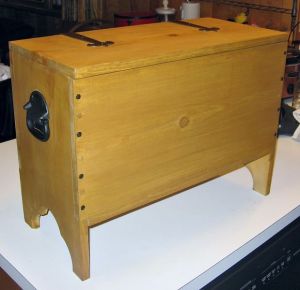
Calon Steel at the Siege of Seville, 844 AD
Originally posted by HL Aiden O’Seaghdha
Calon Steel Schedule!
9am armour/weapons inspections and authorizations
10am Viking Boat tournament
12pm C&T Melee Experiment
1pm C&T free play
Just prior to the Tourney, Judging for the Best Dressed Competition
3pm Viking Sword and Shield Tourney
IF anyone is still froggy we can do free play again after the tourney.
MORE DETAILS TO FOLLOW!
Reclassified as Seljuk Islamic Crossover Coat
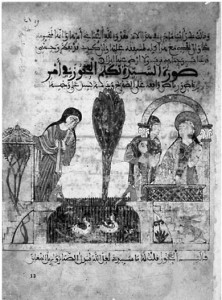
For full clothing description click here
For the Qamisa (undershirt) pattern click here
For the Egyptian Salwar pattern click here
*** The Metropolitan Museum has reclassified the garment I used as inspiration for this project to Seljuk in origin. I do not feel this nulls the research I did on the construction of the garment, although I can no longer ascertain that this garment is from Spain. ***
As previously stated in an earlier post this piece is the most controversial piece I will post in this blog. It has been argued that the coat I have chosen to recreate is possibly from Iran, although the origin is listed by the Metropolitan Museum of Art as probably Spain HAS SINCE BEEN RECLASSIFIED AS SELJUK. So it is possible that this coat was not used in al-Andalus at all, only in all other Islamic cultures of the time period. Up until recently the only images I could locate that depicted the Islamic crossover coat during the 12th and 13th century were of Seljuk origin.
After acquiring the Medieval Andalusian Courtly Culture in the Mediterranean: Hadîth Bayâd wa Riyâd, I was able to locate a very small image from the story of Bayad and Riyad of the Sayyidda, lady of the house, wearing what looks like an Islamic crossover coat with her tavlasan drapped around her shoulders. (Figure 1)
To design a pattern for this coat I used the zoom function on the Met Museum’s website. I was able to zoom in close enough to find seams and cuts in the fabric. I determined the seams by searching the image for breaks in the pattern. In the upper center portion of the coat the neck line is visible. The neck line is straight across the back and very small and close to the neck. On the sleeves there are multiple visible seams that looks like an extensions to make the sleeves longer, which is characteristic of Islamic clothing. The waist line of this coat shows the lines of a coat that is fitted at the waist. The shoulder seams are visible, showing a seam all the way across the shoulders, arms and wrist. The front of the extent piece is missing a section, originally I had thought this must be where a the fabric pieces had joined at a seam citing no matching seam on the opposite side I am driven to assume this piece was cut or torn off due to wear that is evident on the rear panel of the same side of the garment.
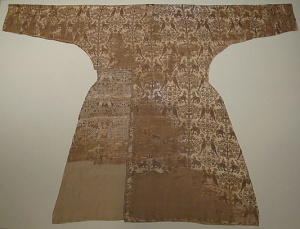
This coat is constructed with three main pieces, two front panels and one rear panel. All of which are cut to the same width at the widest points. This is characteristic of a garment that is cut to the entire width of the fabric used to construct the garment. Both the front and rear sleeves have extension pieces, but the rear has considerably more. I am assuming they used the pieces that were cut from the waist area to add length to the sleeves. One thing that really got my attention when studying this pattern, on the inside of one of the front panels there is what looks to be either a button hole or a loop for a button, I am theorizing this is the closure for the coat and that there would be one on the opposite front panel, but that portion is missing.
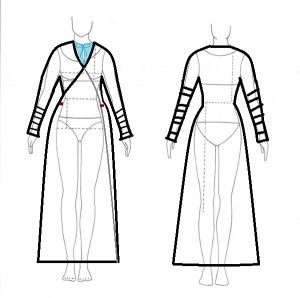
The image above it how the coat should fit once it is completed.
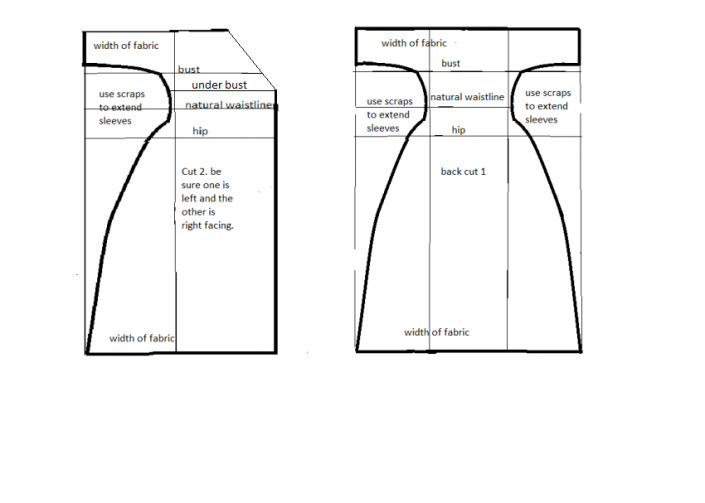
I HIGHLY RECOMMEND DOING A MOCK UP WITH CHEAP FABRIC!!!
Since most silk fabric has a 45 inch width I made this pattern to fit with that. It seems to fit with the seam cuts on the extent piece that this is based off of. If making out of a 54 in width of fabric, you will most likely not need to use scraps for your sleeves, you will just measure those to the correct length and cut in a whole piece. I advise to use a heavier linen if that is your plan, this will make the drape work properly. Too light weight of fabric will not have the same look.
If your fabric is printed with a pattern, be sure you are cutting your front pieces so that you will end up with a left and right side.
On my pattern the vertical lines are at the shoulders
What to measure for front panels:
- shoulder from side of neck to sleeve length
- shoulder to bust
- chest/bust
- from bust to waist
- waist
- waist to hip
- hip
- length from base of neck to ankle
I highly suggest making a pattern with some inexpensive fabric before cutting into something delicious. I originally drew my pattern out on paper before cutting into the silk. And still wished I had made it out of a cheap cotton for practice purposes.
- Draw a straight horizontal line for your shoulder/sleeve. For the right side start at the right edge of the arm and go in towards the neck. This same pattern can be used for the left, so you only need to create one pattern for both.
- Mark the point of your shoulder with a straight line going down the length of your pattern.
- Mark your bust line, under bust line, natural waist line and hip line.
- Draw a horizontal line across for your waistline to the left edge of the pattern piece.
- Connect the neck and underbust with a diagonal line.
- On natural waist line measure 1/2 of your full waist measurement towards the right. This is where your waist will be fitted.
- Go back up to your sleeve, figure out where this short part of the sleeve will fit on your arm. Mine sits at my elbow, measure around that part, divide by 2. draw a straight line down from the right edge of the sleeve that measurement.
- Bring that in at sleeve’s curve to your bust. If you have very large biceps you may want to add an inch or so here, I would make it slightly to big, with cheap fabric and have someone fit it to my arms waist.
- Curve in from armpit/bust area to waist.
- Mark 1/2 of your hip measurement on the pattern, curve the line out to your hip measurement.
- Take that curve straight down to the edge of the length of your pattern.
- Draw a line straight down from the underbust line to the length.
- Draw a line straight across the bottom of the length.
For the back of my pattern, I folded over the overlap of the waist on the front panel, then I folded my fabric in half lengthwise. Lay the straight edge of your pattern about 2 – 3 inches in from the fold, pin and cut out one piece. (the 2-3 inchs will get your to the center of your back as compared to the edge of your neck line.)
The arms will be shorter and you will need to adjust the width of the skirt accordingly.
Cut scraps into rectangular pieces and sew them together to add length to your sleeves. Until either you run out of scraps or you get your desired length of sleeve. The sleeves on this extent piece seem to be normal sleeve length. If you want your sleeves to bunch up at the wrist, you will want to add at least 6 inches to the length.
Use a loop and button or ties to fasten the coat at the under bust line and just above the hip. Both on the inside and outside for a secure fastening.
Please message me if you have any questions. It is much easier to talk about patterning in person, so feel free to ask me questions. Or come to me with a couple of yards of cheap muslin and I will help you drape the coat to fit your body.
Qamisa and Jubba Patterning
I am using the same image here that I have used in many of my other posts. My reasoning is this image, in my opinion, is the best image for viewing the different layers of clothing worn in al-Andalus.
The only image found of the qamisa is located in the Libro de Los Juegos (Figure 1), the color of the qamisa is either white or a very light blue, and it could be a very sheer silk or linen. Due to the climate of al-Andalus I would theorize that it is made of very light weave of linen. Linen is known to wick perspiration away from the body. On the shoulders of the qamisa the artist has rendered a very delicate embroidery pattern. It is unknown exactly what the pattern is, although I would speculate that it is an embroidered tiraz band, pointed stars, or a vine garden motif.
This same image has two very good examples of the Jubba. The Jubba is the main over tunic worn by the men and women in Bayad and Riyad as well as the Libro de Los Juegos. The jubba is always depicted as opaque of color, with a heavy voluminous drape. Many of them are solid in color, some are of striped washi silk, or have medallions woven into the fabric like a lampas silk. (See more descriptions here) The heavy drape of the fabric suggests woven silks or wools. The neckline of the Jubba also sits very high on the neck, about at the clavicle. The neck seems to have an opening that is at the left side of the neck and goes down to toward the left arm. There are no visible ties or buttons, some extant tunics from earlier periods show the neckline closed with ties that would just be tucked in, or a small loop and bead. The neckline of the Jubba is often trimmed with a gold neckline, and tiraz bands just below the shoulders.
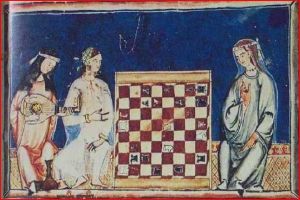 Figure 1: Libro de los Juegos
Figure 1: Libro de los JuegosI have based my pattern off of an extent Egyptian tunic, the construction is geometric and the seams are flat felled.
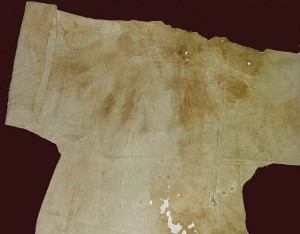 Specimen 73.444 in the collection of the Textile Museum, Washington DC.
Specimen 73.444 in the collection of the Textile Museum, Washington DC.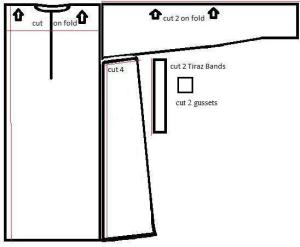 Here is how to layout your pattern
Here is how to layout your pattern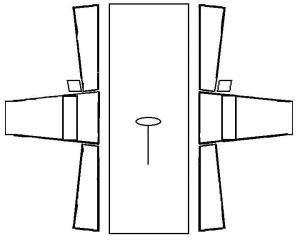 This is how the pieces will fit together.
This is how the pieces will fit together.
- Measure shoulder width across back only.
- Measure sleeve length, add 6 in. For sleeve width measure from shoulder around arm to wrist.
- Measure from shoulder to bust and bust to calf.
- Measure from back of neck to calf.
- Full width of back is width of center body piece. The center body piece can be cut on the fold or you can cut two and add a shoulder seam.
- Length of center piece is from shoulder to calf. Remember to double it if you are cutting on the fold.
- Add approx. 6 in to sleeve length for sleeves.
- Length of side gore is length from bust to calf.
- Width of gore is approx. 4in. more if larger in bust.
- Neck is very high and close to your neck. For Jubba to not add slit, cut neck line to sit at clavicle. Slit will go to sternum for men, navel for women. Tie or loop and button can be used for closure.
- Tiraz band should go around bicep.
Sewing your pieces together:
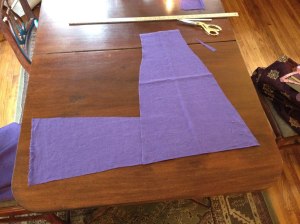 attach side gore to sleeve
attach side gore to sleeve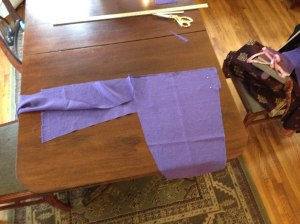 then attach other gore to opposite side of sleeve
then attach other gore to opposite side of sleeve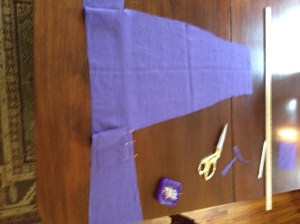 then attach the gussets, repeat all previous steps for both sides
then attach the gussets, repeat all previous steps for both sides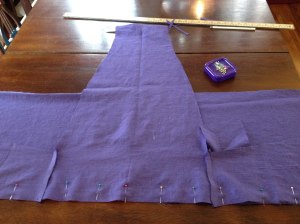 pin to body
pin to body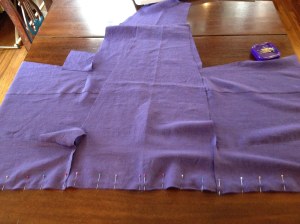 pin other side to body
pin other side to body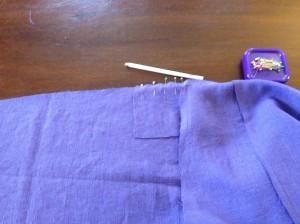 attach the other part of the arm gusset
attach the other part of the arm gusset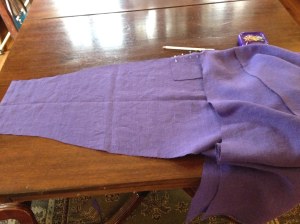 attach other part of the arm gusset on both sides
attach other part of the arm gusset on both sides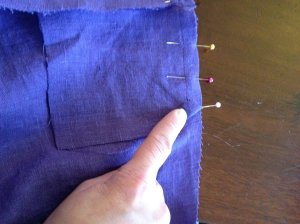 leave a 1/2 inch seam allowance on the gusset
leave a 1/2 inch seam allowance on the gusset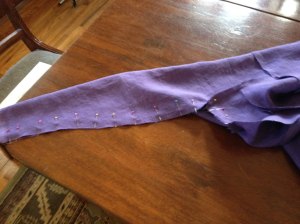 pin sleeves together
pin sleeves together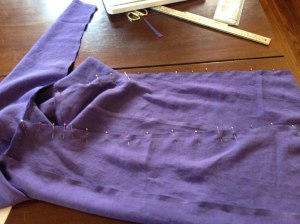 pin sides together, sew from wrist to hem
pin sides together, sew from wrist to hem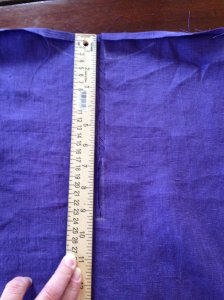 cut the neck slit down the center of the body for women to breast, or navel
cut the neck slit down the center of the body for women to breast, or navel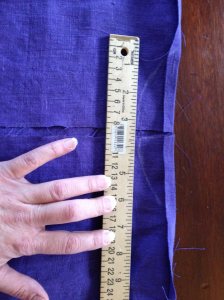 the neck line
the neck line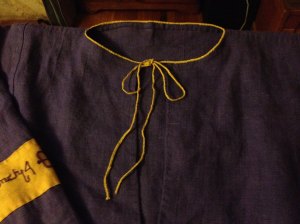 Neck line, I used fingerloop braiding for the tie
Neck line, I used fingerloop braiding for the tie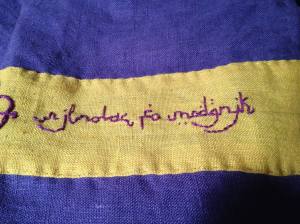 the side of the tiraz band includes vowels and reads backwards in arabesque: Kingdom of Calontir
the side of the tiraz band includes vowels and reads backwards in arabesque: Kingdom of Calontir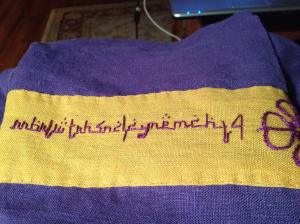 This is a tiraz band in arabesque, it reads backwards with no vowels: 4th company falcons heart waterbearer
This is a tiraz band in arabesque, it reads backwards with no vowels: 4th company falcons heart waterbearer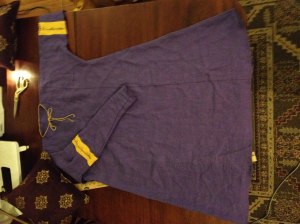 The finished product
The finished product